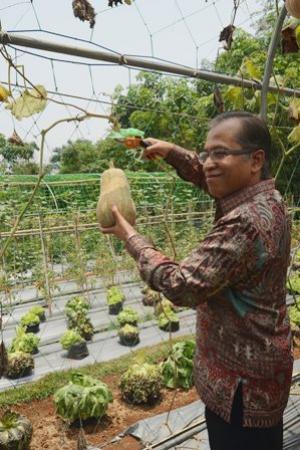National Festival of Pumpkin in IPB Monday, October 13, 2014

Bogor Agricultural University (IPB) in cooperation with PT East West Seed Indonesia and the support of Faculty of Agriculture alumni held a National Pumpkin Festival in Dramaga campus of IPB (8/10). This activity aims to introduce the variety of pumpkins in Indonesia and its utilization as food and decorations.
"Increased knowledge of the use of pumpkin is necessary given that the nutrient content in the pumpkin is high in vitamins A, C and beta-carotene. Further, pumpkin products are expected to support the National Food Diversification. This activity should continue so that the results of the studies by IPB and private companies can be utilized by the community," said Rector of IPB, Prof. Dr. Ir. Herry Suhardiyanto, M.Sc.
According to him, it is important to have the presence of high yielding varieties suitable to the geophysical environment of Indonesia. Besides it can be used by the community, "Let’s open a new space to use pumpkin as a part of our diet," he said.
Meanwhile, according to Director of East West Seed Indonesia, Ir. Glen Pardede, the consumption of Indonesian pumpkin seedling is only a quarter of the total population of Indonesia, compared to the Philippines’, which is 8 times greater. "In the United States consumption of pumpkins is 700,000 tons per year. This means that one American eats 3 kg of pumpkin per capita per year. It is a challenge for us to further promote pumpkin in Indonesia. The primary reason for the low consumption of pumpkin in Indonesia is because the market has not been developed," he explained.
Pumpkin plant is widely known in Indonesia as the stuff to make ‘kolak’ (beverages with coconut milk). Other than Indonesia, the pumpkin has been cultivated in many other countries, such as Taiwan, Australia, Japan, and America. Pumpkin has a high nutritional value with a high content of antioxidants in the form of ß-carotene compounds and vitamin A.
Some researchers say that the pumpkin plays an important role in preventing degenerative diseases such as diabetes mellitus (diabetes), atherosclerosis (narrowing of the arteries), coronary heart disease, high blood pressure, and even can also prevent cancer.
These pumpkins include Sword Pumpkin (Waluh), Squash, Kabocha Pumpkin, and Bottle Pumpkin (Butternut). As food, pumpkin is usually processed into ‘kolak, lunkhead, boiled, for vegetable materials, and flour. In the culinary world, besides as food, pumpkin can also be used as a complement to decoration, good for a stand of fruit or flower decoration or used as a serving container of dish, such as soup, fruit ice and so on.
This Festival involves the farmers and the general public who has a collection of pumpkin plants. The participants will compete to produce a unique pumpkin that would be the best nationally. (Mtd)



